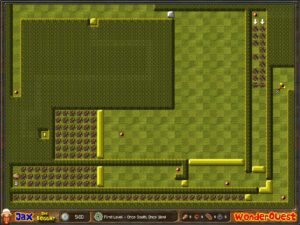Wizardry II: Riddles
The boss fight against the shield on level 2 of Knight of Diamonds is immediately preceded by something new for the engine: a riddle. Wizardry I and II have both had riddle-like things going on before this — notably, on level 1, you get a mysterious hint about how to reach the boss, but the solution there is “use a teleport spell to get past the teleport square that creates the endless-corridor effect”. But here on level 2, for the first time, the game wants you to answer in text, typing in the answer.
It’s not a difficult riddle. It goes on for so long, you’re pretty much guaranteed to figure it out before it’s over, and yet it keeps on going. The thing that impresses me is that it fits so naturally into its environment that I’m not sure I even noticed it was a new mechanic the first time I played through this episode. It just seems like an extension of two things that already existed: spots that give you a bunch of text when you step on them, and spots that block your way unless you’re carrying the right key item.
And that makes me think back to the riddles in Wonderquest. I was quite critical of those, in my most recent post on the game earlier this year. They didn’t seem to fit in at all well there, even though there were in some ways better-integrated with their environment: they had game-mechanical effects beyond letting you do something you could do if they weren’t there, and sometimes the content of the riddles concerned game content. So what gives?
I think what’s really going on is this: Wonderquest is primarily a puzzle game. Wizardry is not. It has puzzlish aspects, like confusing mazes and figuring out how to best take advantage of the mechanics, but it’s not focused on puzzles in the same way that Wonderquest is. So when we see a weak puzzle like a text riddle in Wizardry, it feels like just another manifestation of what it’s been doing all along, just extending its general design philosophy along a different branch. Whereas in Wonderquest, it feels like a downgrade, temporarily abandoning rich and complex mechanical puzzles for something relatively trivial.
 0 Comments
0 Comments